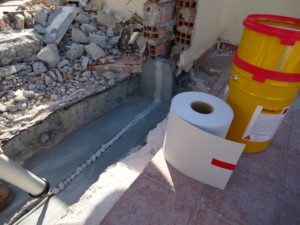
Collective protective equipment
Within protective measures at work, we find both collective protection measures and personal protective equipment, both of which are essential for safety during the working day. In this post, we focus on collective protection measures, such as lifelines, scaffolding, roofs and other elements.
What is Collective Protection?
By collective protection we mean the safety technique aiming at the simultaneous protection of several workers exposed to an occupational hazard;
The first thing to know is that collective protections must never be replaced by individual protections. They are complementary, as we explain below. Thus, from a preventive point of view, collective protections are more effective measures of protection, safety and scope. All means, equipment and collective protection measures have a fixed period of useful life, with an end point, being replaced by a new one at the end of its use. They are, in short, “barriers” that are in charge of protecting workers, objects or tools from falling.
Collective vs individual protection.
A personal protective equipment or PPE is any equipment intended to be worn or held by the worker, in order to protect him from one or more risks which may threaten his safety or health, as well as any complement or accessory intended for this purpose.

The differences between collective and individual protection consist in the fact that the employer, in addition to collective protective equipment, must provide workers with personal protective equipment appropriate to the risk derived from the performance of their duties, informing them of its correct use and ensuring its optimal use and conservation;
Individual PPE is distinguished from collective protection by the volume of workers it protects simultaneously and by the fact that it is a system that reduces the probability of an accident occurring. In other words: individual protection only reduces the consequences of the risk, so that risk control in collective protection is more effective. In addition, PPE can be more limiting in the worker’s movements or visibility;
The most common personal protective equipment are helmets, harnesses, face masks, protective goggles, gloves, filters, waistcoats, protective boots, etc.
Therefore, a clear distinction must be made between these two concepts. The collective affects more people and is purely preventive, whereas PPE only reduces the consequences. In short, personal protection is the last barrier between man and risk, and must be considered as a complementary technique to collective protection. Why? Because collective protection is applied to eliminate the risk situation, while personal protection aims to eliminate or mitigate the consequences and risks to the worker’s health.
Regulations on collective protection.
We said that collective protection is the safety technique that seeks the simultaneous protection of several workers exposed to a given risk. In this sense, article 15.1 h of the LPRL (Prevention of Risks at Work) specifies that, with regard to risk prevention, measures must be adopted that put collective protection before individual protection. It is when adapting these measures, and as a complement to them, when we move on to using individual protection measures, for the exclusive use of one person. This is also included in article 17.2 of the Law of Occupational Risk Prevention.

Thus, the collective action and protection systems allow rapid action to control incidents and serious accidents, whether they are fires, explosions, falls from heights and many other situations;
As for the regulations, there is a specific one for health and safety signage at work, as well as the surveillance of collective protections in the maintenance of the minimum health and safety provisions in construction sites, among others. In any case, workplaces must comply with the minimum provisions set out in RD 486/1997, which establishes the minimum health and safety provisions in workplaces in terms of construction conditions, order, signage, cleaning and maintenance, service installations, environmental conditions, etc.
And, of course, it is compulsory to use collective protection equipment on construction sites. Collective protective elements must be taken into account in any building renovation project, façade refurbishment, etc. on the basis of their design, installation and maintenance;
Most common collective protection measures. What are they??
It is the type of work that determines the collective protection measures, as well as the working environment, the risks to the worker and other factors.
Some of the most important collective systems for work at heights, as well as for work with compulsory lifelines, roof repairs, façade rehabilitation, and a long etcetera, are some of the most important collective systems:
- The building lifeline: These are an element aimed at guaranteeing safety when carrying out any task in construction. This fall arrest system is used with the aim of increasing the level of safety of workers and operators who are carrying out different types of work in different types of constructions. In most cases, when it is a construction site, a temporary lifeline is used, while in the case of buildings, industrial buildings and other constructions where workers may need a lifeline at different times for maintenance, then a fixed lifeline is installed. If you want to know more about how to deal with fall hazards on construction sites and the installation of lifelines, we leave you the link to our blog where you can find more information.
- Handrails, walkways and ladders: They are one of the keys to avoid problems such as falls and accidents. They are consumer and labour protection systems.
- Order and cleanliness: As simple as it is effective in preventing accidents and even illnesses such as infections.
- Scaffolding: Crucial in the rehabilitation of facades and buildings. Temporary, fixed or mobile temporary construction to access otherwise inaccessible construction site areas and to carry materials and work tools to these areas.
- Ventilation systems and extractor hoods: To avoid toxicity and make the air breathable.
- Sound/noise protection barriers: In addition to hard hats or earplugs, sound barriers and sound insulation can be included.
- Perimeter fencing of work areas: This is also very common on construction sites.
- Redes de seguridad: Limitan la altura de las caídas. Deben ser flexibles y cubrir todo el espacio donde haya riesgo de caída.
- Sistemas Provisionales de Protección de Borde: Impiden la caída de personas y materiales desde bordes, escaleras, huecos, tejados y otras superficies de trabajo horizontales e inclinadas.
- Marquesinas: Diseñadas para retener la caída de objetos y materiales desde niveles superiores, evitando de esta manera el riesgo de impacto sobre las personas que circulan o trabajan en niveles inferiores.
- Extintores de incendios: Van de los extintores a las instalaciones de detección de humos y antincendios.
- Medios húmedos en ambientes polvorientos.
- Carcasa de protección de motores o piezas en continuo movimiento.
- Señalizaciones e indicativos: Su misión es alertar a los trabajadores de peligros, riesgos o prácticas concretas a tomar para prevenir accidentes laborales
- Barreras de protección térmicas en centros de trabajo: Proporcionan condiciones ambientales y de temperatura adecuadas para ejecutar debidamente las tareas propias del puesto laboral.
La seguridad, cuestión de profesionales
At Rodríguez Ros we specialise in the installation of lifelines, safety at heights and all types of collective protection measures. For more information, and if you would like to obtain a personalised, no-obligation quote, do not hesitate to contact us.
















